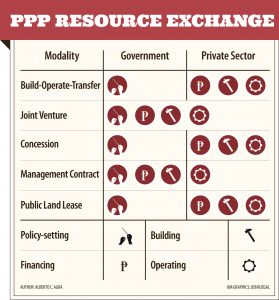‘Responsive-ility’ and responsibility Public-Private Partnership (PPP) arrangements—whether for water, reclamation, power, mass transport systems and…
PPP is about resource exchange and interdependence
PPP is about resource exchange and interdependence
 Are the resources of government sufficient to be able to undertake all infrastructure projects and public services? What are the contributions of government and the private sector in a public-private partnership (PPP)? What is in it for the people, government and the private sector when it participates in a PPP? Should there be a triple win arrangement?
Are the resources of government sufficient to be able to undertake all infrastructure projects and public services? What are the contributions of government and the private sector in a public-private partnership (PPP)? What is in it for the people, government and the private sector when it participates in a PPP? Should there be a triple win arrangement?
At the project level, a PPP is a contractual arrangement between the government and the private sector to deliver public infrastructure and/or public services, where each party assumes specified functions, bears certain risks, provides contributions, performs particular obligations, and earns benefits and revenues. Without the contributions, support, participation and resources of each party and every stakeholder, there can be no feasible PPP.
Government resources in a PPP can be a concession or franchise, subsidy, funds, land and personnel, without which, there can be no viable PPP. The private sector can contribute the capital, expertise, technology and manpower, without which, there can be no PPP.
Thus, the relationship between them is one of resource exchange and interdependence. According to Pfeffer and Salancik, interdependence exists whenever one actor does not entirely control all of the conditions necessary for the achievement of an action or for obtaining the outcome desired from the action. Government must be able to transact with elements of the environment, i.e., business sector, civil society and ordinary citizens, in order to obtain the resources necessary for survival and performance of
its mandate.
It is for these reasons that the public sector needs the private sector, and vice versa since they are not self-contained and self-sufficient organizations. A partnership is not one-sided or lopsided.
In a PPP, there is no competition between the parties. There should be symbiotic relationship based on trust and resource exchange. In a PPP, after the PPP contract has been awarded, there is either a monopoly or monopsony.
In the bidding process, there is competition “for” the market, but after the award, there is no competition “in” the market.
Surely, one party cannot dominate, or have control over the other, save what is provided and agreed upon in the PPP contract. Resource exchange is critical in a PPP, where the effects and relationship are moderated by the PPP contract, the bid documents and the public good.
However, in a system of interdependence, the identity of each party remains intact. The government cannot abdicate its duty to regulate, set policies, “steer” the project, ensure delivery of basic services, and protect and promote the interest of the people. On the other hand, the private sector cannot enter into contracts that will harm or cause disadvantage to its shareholders. For the consumers, they exercise their freedom to use or not to use the facility, and to support or oppose a project.
In interdependence and resource exchange, there must be a triple win or benefit situation on the part of the government, the private sector and the people, otherwise, there is no reason to collaborate or support a partnership. Win-win-win is both a commitment and a challenge.
